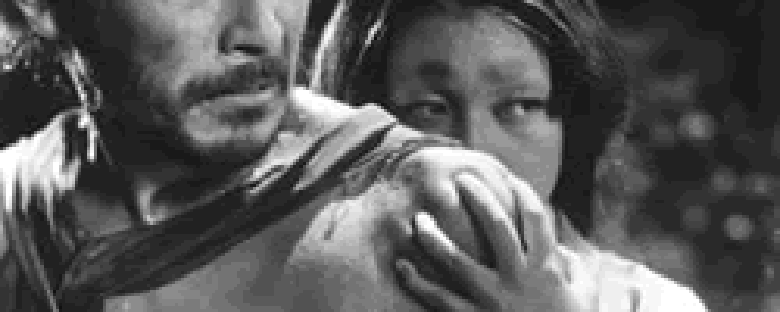Reviews
Akira Kurosawa
Japan, 1950
Credits
Review by Rumsey Taylor
Posted on 11 July 2004
Source The Criterion Collection DVD
Drifters convene underneath the crumbling façade of the abandoned Rashomon gate (at the entrance to Japan’s former capital, Kyoto), seeking shelter in a relentless flood of rain. The weather (which is, despite the film’s wear, tangible) prohibits clear sight. Appropriately, the credits montage is constructed of static shots that display growing puddles and rotting architecture. The storm pollutes the scene, robs its contrast, and turns everything into an even, consistent gray. The image is a fitting introduction to Rashomon, as there will be no absolute clarity for events depicted in the film.
Akira Kurosawa’s twelfth feature, Rashomon opened to international laurels, including Best Picture at the Venice Film Festival and an Honorary Oscar in 1952 (its critical success led presumably to the “Best Foreign Film” category). It was an immeasurable coup for Japanese cinema, which was natively isolated prior.
Its premise is deceptively simple (Rashomon’s simplicity is of particular note due to the epic structure and vision of Kurosawa’s later films): a samurai is found murdered. He (present through a medium), his wife, a bandit, and a woodcutter each lend their testimony; three claim to be responsible for the killing. The notion of truth, or rather its subjective fallibility is examined, here, yet in spite of its wealth of possible actions Rashomon supplies no closure — this is the film’s innovative strength, and lasting contribution to the body of film.
In film there is the presumption that the medium relays a relative truth. With any filmed action the viewer may evaluate its details, limited only by technical embellishments such as composition and sound, and procure a contextually isolated truth. With even the subtlest action such as a line of dialogue, film is traditionally constructed to relay the fact that it was spoken within a context. It is an idea that truth may be discerned within an acknowledged fiction. Rashomon contests this presumption by constructing a scenario that, befitted by this traditional interpretation, has no truth — or rather, hinders the viewer’s ability to procure it.
Rashomon airs the same scene four times, subsequently reconstructing it according to four perspectives (each is a differentiated, if not contradictive version). It is a murder not in which the perpetrator is sought but rather the very action, as three involved have, again, claimed responsibility for the death. Assigning guilt is not the issue, but rather achieving the most plausible certainty between those who plead it.
There is an obsessively patient and virtuosic sequence in which the woodcutter enters a forest. There are repeated shots aimed directly behind the forest ceiling. As the woodcutter progresses, the light, in these repeated shots, becomes more shrouded (in this symbolic manner, the objective accuracy of the to-be-repeated episode diminishes). The montage escalates. The editing rhythm increases, and the view moves closer, culminating in the woodcutter’s discovery of the body.
In result, the woodcutter relays his testimony. Here, Rashomon’s innovative strength is apparent: the woodcutter is seated in front of a predominantly white, nondescript background, and speaks to a jury audience — which is unseen outside of the frame. The viewer is addressed directly, and is to amass the evidence and to discern truth. This tactic engages the viewer and enables the film’s metaphysical capacity.
The woodcutter establishes the indisputable facts of the crime, tellingly arranging them with the precision of a table of evidence: a discarded woman’s hat with veil lain on a bush, a trampled samurai cap, a length of cut rope, an amulet case, and the samurai’s body, slain by a sword.
The aforementioned bandit is found with the samurai’s arrows, bow, and horse. He is captured and interrogated (in the same manner as the woodcutter). The bandit is easily convictable: sweaty and brash, with a hand that leaves his sword frequently to tame an invisible swarm of mosquitoes about him at any moment. At the very moment he begins to speak the narrative reliability of Rashomon is abandoned.
The bandit’s version of the story is lent a visual depiction, as with each testimony, and watching it one may look for recurring details, such as the location of the wife’s dagger, or the staging of a swordfight between the samurai and bandit. Each testimony (the wife, murdered husband, and woodcutter follow) is tainted by the persuasion of its teller: the bandit wants to assure his prowess as a fighter (in his delivery, his fight with the samurai is climactic and heavily in his favor); the wife wants to maintain her feminine respectability; the husband defends his honor as a samurai; the woodcutter supports his argument that men are inherently dishonest. In each version the action is exclusively manipulated by personal politics and sex, and in each the teller is the most sympathetic, responsible, and honorable witness. Thusly, not one is in a more trusted position than another.
The film has acquired as durable a critical foundation as any film (it is a staple in film courses). It is laudable foremost for its very use of its medium and as singularly influential as any film in history.
We don’t do comments anymore, but you may contact us here or find us on Twitter or Facebook.



